- Home
- Bill Bryson
Notes from a Small Island Page 3
Notes from a Small Island Read online
Page 3
He looked up from his thoughts to where I was pointing, gave a deeply gloomy nod as if to say, ‘Alas, yes,’ and trudged on.
‘Well, fancy,’ I murmured and went to see the town.
Calais is an interesting place that exists solely for the purpose of giving English people in shell suits somewhere to go for the day. Because it was heavily bombed in the war, it fell into the hands of post-war town planners and in consequence looks like something left over from a 1957 Exposition du Cement. An alarming number of structures in the centre, particularly around the cheerless Place d’Armes, seem to have been modelled on supermarket packaging,primarily packets of Jacob’s Cream Crackers. A few structures are even built across roads - always a sign of 1950s planners smitten with the novel possibilities of concrete. One of the main buildings in the centre, it almost goes without saying, is a Holiday Inn/ cornflakes box.
But I didn’t mind. The sun was shining in a kindly Indian summer way and this was France and I was in that happy frame of mind that always comes with the start of a long trip and the giddy prospect of spending weeks and weeks doing nothing much and calling it work. My wife and I had recently taken the decision to move back to the States for a bit, to give the kids the chance of experiencing life in another country and my wife the chance to shop until 10 p.m. seven nights a week. I had recently read that 3.7 million Americans, according to a Gallup poll, believed that they had been abducted by aliens at one time or another, so it was clear that my people needed me. But I had insisted on having one last look at Britain - a kind of valedictory tour round the green and kindly island that had so long been my home. I had come to Calais because I wanted to re-enter England as I’d first seen it, from the sea. Tomorrow I would catch an early ferry and begin the serious business of investigating Britain, examining the nation’s public face and private parts, as it were, but today I was carefree and unattached. I had nothing to do but please myself.
I was disappointed to note that nobody on the streets of Calais looked like Yves Montand or Jeanne Moreau or even the delightful Philippe Noiret. This was because they were all Britons dressed in sportswear. They all looked as if they should have whistles around their necks and be carrying footballs. Instead, they were lugging heavy carrier-bags of clinking bottles and noisome cheeses and wondering why they had bought the cheese and what they were going to do with themselves until it was time to catch the four o’clock ferry home. You could hear them bickering in small, unhappy voices as they passed. ‘Sixty francs for a packet of bloody goat’s cheese? Well, she won’t thank you for that.’ They all looked as if they ached for a nice cup of tea and some real food. It occurred to me that you could make a small fortune with a hamburger stand. You could call it Burgers of Calais.
It must be said that apart from shopping and bickering quietly there isn’t a great deal to do in Calais. There’s the famous Rodin statue outside the Hotel de Ville and a single museum, the Musee des Beaux-Arts et de la Dentelle (‘The Museum of Beautiful Art and
of the Teeth’, if my French hasn’t abandoned me), but the museum was closed and the Hotel de Ville was a long slog - and anyway the Rodin statue is on every postcard. I ended up, like everyone else, nosing around the souvenir shops, of which Calais has a certain amplitude.
For reasons that I have never understood, the French have a particular genius when it comes to tacky religious keepsakes, and in a gloomy shop on a corner of the Place d’Armes, I found one I liked: a plastic model of the Virgin Mary standing with beckoning arms in a kind of grotto fashioned from seashells, miniature starfish, lacy sprigs of dried seaweed and a polished lobster claw. Glued to the back of the Madonna’s head was a halo made from a plastic curtain ring, and on the lobster claw the model’s gifted creator had painted an oddly festive-looking ‘Calais!’ in neat script. I hesitated because it cost a lot of money, but when the lady of the shop showed me that it also plugged in and lit up like a funfair ride at Margate, the only question in my mind was whether one would be enough.
‘C’est tres jolie,’ she said in a kind of astonished hush when she realized that I was prepared to pay real money for it, and bustled off to get it wrapped and paid for before I came to my senses and cried, ‘Say, where am I? And what, pray, is this tacky piece of Franco-merde I see before me?’
‘C’est tres jolie,’ she kept repeating soothingly, as if afraid of disturbing my wakeful slumber. I think it may have been some time since she had sold a Virgin-Mary-with-Seashells Occasional Light. In any case, as the shop door shut behind me, I distinctly heard a whoop of joy.
Afterwards, to celebrate, I called in for a coffee at a popular cafe on the rue de Gaston Papin et Autres Dignitaires Obscures. Indoors, Calais seemed much more agreeably Gallic. People greeted each other with two-cheeked kisses and wreathed themselves in blue smoke from Gauloises and Gitanes. An elegant woman in black across the room looked uncannily like Jeanne Moreau having a quick fag and a Pernod before playing a funeral scene in a movie called La Vie Drearieuse. I wrote a postcard home and enjoyed my coffee, then passed the hours before dusk waving in a friendly but futile way at the bustling waiter in the hope of coaxing him back to my table to settle my modest account.
I dined cheaply and astonishingly well at a little place across the road - there is this to be said for the French: they can make chips -drank two bottles of Stella Artois in a cafe, where I was served bya Philippe Noiret lookalike in a slaughterhouse apron, and retired early to my modest hotel room, where I played with my seashell Madonna for a bit, then got into bed and passed the night listening to cars crashing in the street below.
In the morning, I breakfasted early, settled my bill with Gerard Depardieu - now there was a surprise - and stepped out to another promising day. Clutching an inadequate little map that came with my ferry ticket, I set off in search of the ferry terminus. On the map it looked to be quite near by, practically in the town centre, but in reality it was a good two miles away at the far end of a bewildering wasteland of oil refineries, derelict factories, and acres of waste ground strewn with old girders and piles of jagged concrete. I found myself squeezing through holes in chainlink fences and picking my way between rusting railway carriages with broken windows. I don’t know how other people get to the ferry at Calais, but I had the distinct feeling that no-one had ever done it this way before. And all the while I walked I was uncomfortably aware - actually in a whimpering panic - that departure time was drawing nigh and that the ferry terminus, though always visible, never seemed to get any closer.
Eventually, after dodging across a dual carriageway and clambering up an embankment, I arrived breathless and late and looking like someone who’d just survived a mining disaster, and was hustled aboard a shuttle bus by an officious woman with a serious case of dysmenorrhoea. On the way, I took stock of my possessions and discovered with quiet dismay that my beloved and costly Madonna had lost her halo and was shedding seashells.
I boarded the ship perspiring freely and with a certain disquiet. I’m not a good sailor, I freely admit. I get sick on pedalos. Nor was I helped by the fact that this was one of those Ro-Ro ferries (short for roll on, roll over) and that I was entrusting my life to a company that had a significantly less than flawless record when it came to remembering to shut the bow doors, the nautical equivalent of forgetting to take off your shoes before getting into the bath.
The boat was chock-a-block with people, all of them English. I spent the first quarter of an hour wandering around wondering how they had got there without getting filthy, inserted myself briefly into the shell-suited mayhem that was the duty-free shop and as quickly found my way out again, strolled around the cafeteria with a tray looking at the food and then put the tray back (there was a queue for this), searched for a seat among hordes of dementedly lively children, and finally found my way out onto the breezy deck where 274 people with blue lips and dancing hair were trying to convince themselves that because the sun was shining they couldn’t possibly be cold. The wind whipped our anoraks with a sound l
ike gunshot, scooted small children along the deck and, to everyone’s private gratification, tipped a styrofoam cup of tea onto a fat lady’s lap.
Before long, the White Cliffs of Dover rose from the sea and began creeping towards us and in no time at all, it seemed, we were sailing into Dover Harbour and clumsily nuzzling up to the dock. As a disembodied voice instructed foot passengers to assemble at the starboard egress point on Deck ZX-2 by the Sunshine Lounge - as if that meant anything to anybody - we all embarked on long, befuddled, highly individual explorations of the ship: up and down stairways, through the cafeteria and club-class lounge, in and out of storerooms, through a kitchen full of toiling lascars, back through the cafeteria from another angle, and finally - without knowing quite how - out into the welcoming, watery sunshine of England.
I was eager to see Dover again after all these years. I strode into the centre along Marine Parade and with a small cry of pleasure spied the shelter I’d slept in those many years ago. It was covered in about eleven more layers of bile-green paint but otherwise unchanged. The view out to sea was likewise unchanged, though the water was bluer and more glittery than when I’d last seen it. But everything else looked different. Where I recalled there being a row of elegant Georgian terraces there was now a vast and unbecoming brick apartment block. Townwall Street, the main through road to the west, was wider and more menacing with traffic than I remembered, and there was now a subway to the town centre, which itself was unrecognizable.
The main shopping street had been pedestrianized and the Market Square had been turned into a kind of piazza with show-off paving and the usual array of cast-iron trimmings. The whole town centre seemed uncomfortably squeezed by busy, wide relief roads of which I had no recollection and there was now a big tourist edifice called the White Cliffs Experience, where, I presume from the name, you can discover what it feels like to be 800-million-year-old chalk. I didn’t recognize anything. The trouble with English towns is that they are so indistinguishable one from another. They all have a Boots and W.H. Smith and Marks & Spencer. You could be anywhere really.I plodded distractedly through the streets, unhappy that a place so central to my memories was so unfamiliar. Then, on my third grumbling pass through the town centre, on a lane I would swear I had never walked before, I came across the cinema, still recognizable as the home of Suburban Wife-Swap despite a heavy patina of arty refurbishment, and everything suddenly became clear. Now that I had a fixed point of reference, I knew precisely where I was. I strode purposefully 500 yards north and then west - now I could almost have done it blindfolded - and found myself square in front of Mrs Smegma’s establishment. It was still a hotel and looked substantially unchanged, as far as I could remember, except for the addition of some hardstanding in the front garden and a plastic sign announcing colour TVs and en suite bathrooms. I thought about knocking at the door, but there didn’t seem much point. The dragonlike Mrs Smegma must be long since gone - retired or dead or perhaps resident in one of the many nursing homes that crowd the south coast. She couldn’t possibly have coped with the modern age of British guesthouses, with their en suite bathrooms and coffee-making facilities and people having pizzas delivered to their rooms.
If she is in a nursing home, which would certainly be my first choice, I do hope the staff have the compassion and good sense to scold her frequently for dribbling on the toilet seat, leaving her breakfast unfinished and generally being helpless and tiresome. It would do so much to make her feel at home.
Cheered by this thought, I strolled up the Folkestone Road to the rail station and bought a ticket for the next train to London.
CHAPTER TWO
GOODNESS ME, BUT ISN’T LONDON BIG? IT SEEMS TO START ABOUT
twenty minutes after you leave Dover and just goes on and on, mile after mile of endless grey suburbs with their wandering ranks of terraced houses and stuccoed semis that always look more or less identical from a train, as if they’ve been squeezed out of a very large version of one of those machines they use to make sausages. How, I always wonder, do all the millions of occupants find their way back to the right boxes each night in such a complex and anonymous sprawl?
I’m sure I couldn’t. London remains a vast and exhilarating mystery to me. I lived and worked in or around it for eight years, watched London news on television, read the evening papers, ranged extensively through its streets to attend weddings and retirement parties or go on hare-brained quests for bargains in far-flung breakers’ yards, and still I find that there are great fragments of it that I have not just never visited but never heard of. It constantly amazes me to read the Evening Standard or chat with an acquaintance and encounter some reference to a district that has managed to elude my ken for twenty-one years. ‘We’ve just bought a little place in Fag End, near Tungsten Heath,’ somebody will say and I’ll think, I’ve never even heard of that. How can this possibly be?
I had stuck a London A-Z in my rucksack and came across it now while searching unsuccessfully for half a Mars bar I was sure was in there. Plucking it out, I idly leafed through its busy pages, as ever amazed and quietly excited to find it peppered with districts, villages, sometimes small swallowed cities whose names, I would swear, had not been there the last time I looked - Dudden Hill, Plashet, Snaresbrook, Fulwell Cross, Elthorne Heights, Higham Hill, Lessness Heath, Beacontree Heath, Bell Green, Vale of Health. And the thing is, I know that the next time I look there will be other, different names. It is as deep a mystery to me as the lost tablets of Titianca or the continuing appeal to millions of Noel Edmonds.
I have the greatest admiration for the A-Z and the way it scrupulously fixes and identifies every cricket ground and sewage works, every forgotten cemetery and wandering suburban close, and packs the densest names on to the tiniest, obscurest spaces. I flipped to the index and, for want of anything better to do, absorbed myself there. I calculated that there are 45,687 street names in London (give or take), including 21 Gloucester Roads (as well as a generous slew of Gloucester Crescents, Squares, Avenues and Closes), 32 Mayfields, 35 Cavendishes, 66 Orchards, 74 Victorias, 111 Station Roads or similar, 159 Churches, 25 Avenue Roads, 35 The Avenues, and other multiples without number. There are, however, surprisingly few really interesting sounding places. There are a few streets that sound like medical complaints (Glyceina Avenue, Shingles Lane, Burnfoot Avenue), a few that sound like names on an anatomical chart (Thyrapia and Pendula Roads), a few that sound vaguely unsavoury (Cold Blow Lane, Droop Street, Gutter Lane, Dicey Avenue), and a few that are pleasingly ridiculous (Coldbath Square, Glimpsing Green, Hamshades Close, Cactus Walk, Nutter Lane, The Butts), but there is very little that could be called truly arresting. I read once that in Elizabethan times there was a Gropecunt Lane somewhere in the City, but evidently no longer. I spent half an hour amusing myself in this way, pleased to be entering a metropolis of such dazzling and unknowable complexity, and had the bonus pleasure, when I returned the book to the bag, of finding the half-eaten Mars bar, its leading edge covered in a small festival of lint, which didn’t do a great deal for the flavour but did add some useful bulk.
Victoria Station was swarming with the usual complement of lost-looking tourists, lurking touts and passed-out drunks. I can’t remember the last time I saw anyone at Victoria who looked like he was there to catch a train. On my way out, three separate people enquired whether I had any spare change - ‘No, but thank you for asking!’ - which wouldn’t have happened twenty years ago. Then,
not only were panhandlers something of a novelty but they always had a good story about having lost their wallet and desperately needing £2 to get to Maidstone to donate bone marrow to their kid sister or something, but now they just flatly ask for money, which is quicker but less interesting.
I took a cab to Hazlitt’s Hotel on Frith Street. I like Hazlitt’s because it’s intentionally obscure - it doesn’t even have a sign out front - which puts you in a rare position of strength with your cab driver. Let me say right now that London cab drivers are, with
out question, the finest in the world. They’re trustworthy, safe, generally friendly, always polite. They keep their vehicles spotless inside and out, and they will put themselves to the most extraordinary inconvenience to drop you at the front entrance of your destination. There are really only two odd things about them. One is that they cannot drive more than 200 feet in a straight line. I’ve never understood this, but no matter where you are or what the driving conditions, every 200 feet a little bell goes off in their heads and they abruptly lunge down a side-street. And when you get to your hotel or railway station or wherever it is you are going, they like to drive you all the way around it at least once so that you can see it from all angles before alighting.
The other distinctive thing about them, and the reason I like to go to Hazlitt’s, is that they cannot bear to admit that they don’t know the location of something they feel they ought to know, like a hotel. They would sooner entrust their teenaged daughters to Alan Clark for a weekend than concede even fractional ignorance of The Knowledge, which I think is rather sweet. So what they do instead is probe. They drive for a bit, then glance at you in the mirror and in an over-casual voice say, ‘Hazlitt’s - that’s the one on Curzon Street, innit, guv? Opposite the Blue Lion?’ But the instant they see a knowing smile of demurral forming on your lips, they hastily say, ‘No, hang on a minute, I’m thinking of the Hazelbury. Yeah, the Hazelbury. You want Hazlitt’s, right?’ He’ll drive on a bit in a fairly random direction. ‘That’s this side of Shepherd’s Bush, innit?’ he’ll suggest speculatively.
When you tell him that it’s on Frith Street, he says, ‘Yeah, that’s the one. Course it is. I know it - modern place, lots of glass.’
‘Actually, it’s an eighteenth-century brick building.’
‘Course it is. I know it.’ And he immediately executes a dramatic U-turn, causing a passing cyclist to steer into a lamppost (but that’s all right because he has on cycle clips and one of those geeky slipstream helmets that all but invite you to knock him over). ‘Yeah, you had me thinking of the Hazelbury,’ the driver adds, chuckling as if to say it’s a lucky thing he sorted that one out for you, and then lunges down a little side-street off the Strand called Running Sore Lane or Sphincter Passage, which, like so much else in London, you had never noticed was there before.

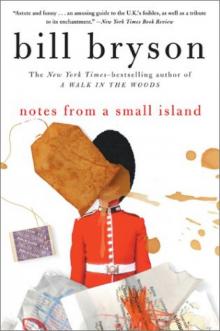 Notes from a Small Island
Notes from a Small Island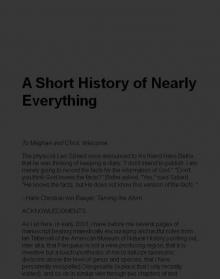 A Short History of Nearly Everything
A Short History of Nearly Everything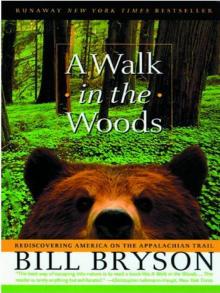 A Walk in the Woods
A Walk in the Woods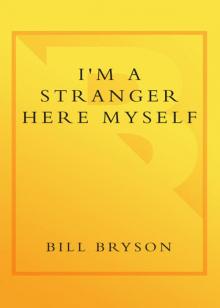 I'm a Stranger Here Myself
I'm a Stranger Here Myself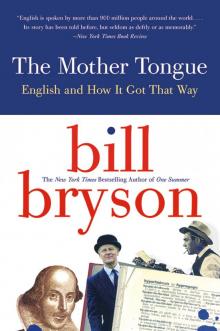 The Mother Tongue
The Mother Tongue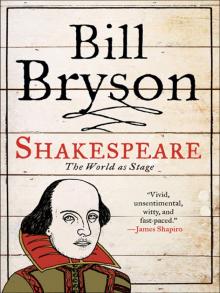 Shakespeare
Shakespeare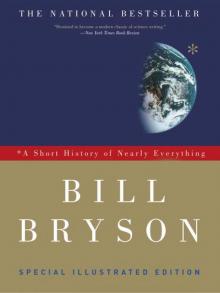 A Short History of Nearly Everything: Special Illustrated Edition
A Short History of Nearly Everything: Special Illustrated Edition The Best American Travel Writing 2016
The Best American Travel Writing 2016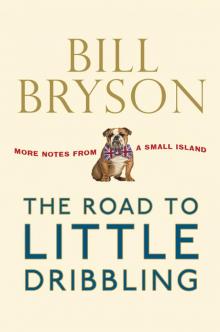 The Road to Little Dribbling
The Road to Little Dribbling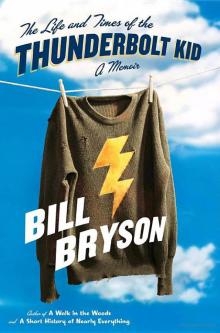 The Life And Times Of The Thunderbolt Kid: A Memoir (v5.0)
The Life And Times Of The Thunderbolt Kid: A Memoir (v5.0) Made In America
Made In America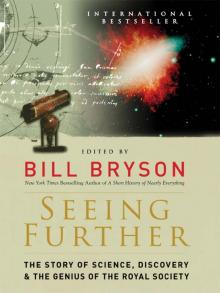 Seeing Further
Seeing Further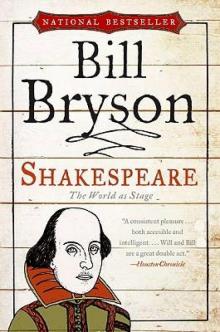 Shakespeare: The World as Stage
Shakespeare: The World as Stage The Life and Times of the Thunderbolt Kid
The Life and Times of the Thunderbolt Kid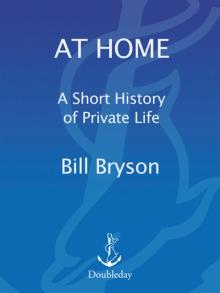 At Home
At Home Bryson's Dictionary For Writers And Editors (v5.0)
Bryson's Dictionary For Writers And Editors (v5.0) Neither Here Nor There
Neither Here Nor There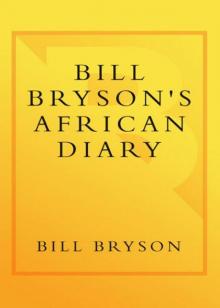 Bill Bryson's African Diary
Bill Bryson's African Diary